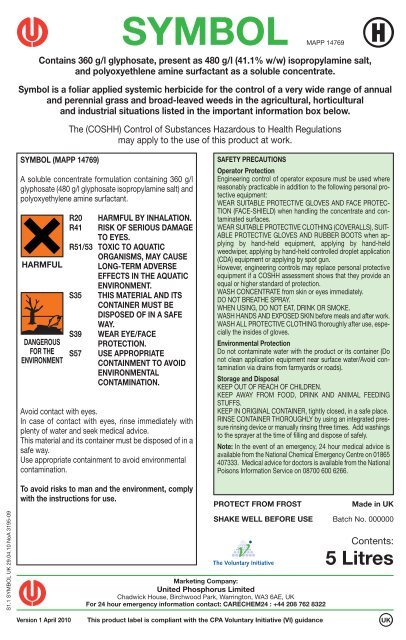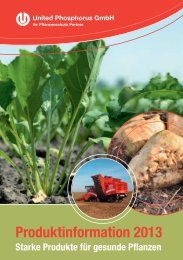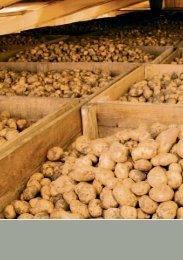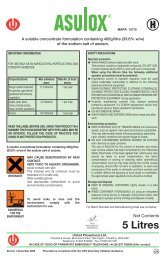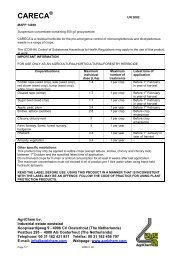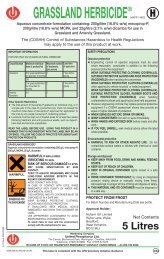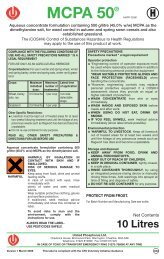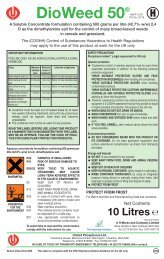SYMBOL - United Phosphorus Limited
SYMBOL - United Phosphorus Limited
SYMBOL - United Phosphorus Limited
Create successful ePaper yourself
Turn your PDF publications into a flip-book with our unique Google optimized e-Paper software.
S1.1 <strong>SYMBOL</strong> UK 29.04.10 NoA 3195-09<br />
<strong>SYMBOL</strong><br />
Contains 360 g/l glyphosate, present as 480 g/l (41.1% w/w) isopropylamine salt,<br />
and polyoxyethlene amine surfactant as a soluble concentrate.<br />
Symbol is a foliar applied systemic herbicide for the control of a very wide range of annual<br />
and perennial grass and broad-leaved weeds in the agricultural, horticultural<br />
and industrial situations listed in the important information box below.<br />
<strong>SYMBOL</strong> (MAPP 14769)<br />
The (COSHH) Control of Substances Hazardous to Health Regulations<br />
may apply to the use of this product at work.<br />
A soluble concentrate formulation containing 360 g/l<br />
glyphosate (480 g/l glyphosate isopropylamine salt) and<br />
polyoxyethylene amine surfactant.<br />
HARMFUL<br />
DANGEROUS<br />
FOR THE<br />
ENVIRONMENT<br />
R20 HARMFUL BY INHALATION.<br />
R41 RISK OF SERIOUS DAMAGE<br />
TO EYES.<br />
R51/53 TOXIC TO AQUATIC<br />
ORGANISMS, MAY CAUSE<br />
LONG-TERM ADVERSE<br />
EFFECTS IN THE AQUATIC<br />
ENVIRONMENT.<br />
S35 THIS MATERIAL AND ITS<br />
CONTAINER MUST BE<br />
DISPOSED OF IN A SAFE<br />
WAY.<br />
S39 WEAR EYE/FACE<br />
PROTECTION.<br />
S57 USE APPROPRIATE<br />
CONTAINMENT TO AVOID<br />
ENVIRONMENTAL<br />
CONTAMINATION.<br />
Avoid contact with eyes.<br />
In case of contact with eyes, rinse immediately with<br />
plenty of water and seek medical advice.<br />
This material and its container must be disposed of in a<br />
safe way.<br />
Use appropriate containment to avoid environmental<br />
contamination.<br />
To avoid risks to man and the environment, comply<br />
with the instructions for use.<br />
MAPP 14769<br />
Marketing Company:<br />
<strong>United</strong> <strong>Phosphorus</strong> <strong>Limited</strong><br />
Chadwick House, Birchwood Park, Warrington, WA3 6AE, UK<br />
For 24 hour emergency information contact: CARECHEM24 : +44 208 762 8322<br />
Version 1 April 2010 This product label is compliant with the CPA Voluntary Initiative (VI) guidance<br />
UK<br />
H<br />
SAFETY PRECAUTIONS<br />
Operator Protection<br />
Engineering control of operator exposure must be used where<br />
reasonably practicable in addition to the following personal protective<br />
equipment:<br />
WEAR SUITABLE PROTECTIVE GLOVES AND FACE PROTEC-<br />
TION (FACE-SHIELD) when handling the concentrate and contaminated<br />
surfaces.<br />
WEAR SUITABLE PROTECTIVE CLOTHING (COVERALLS), SUIT-<br />
ABLE PROTECTIVE GLOVES AND RUBBER BOOTS when applying<br />
by hand-held equipment, applying by hand-held<br />
weedwiper, applying by hand-held controlled droplet application<br />
(CDA) equipment or applying by spot gun.<br />
However, engineering controls may replace personal protective<br />
equipment if a COSHH assessment shows that they provide an<br />
equal or higher standard of protection.<br />
WASH CONCENTRATE from skin or eyes immediately.<br />
DO NOT BREATHE SPRAY.<br />
WHEN USING, DO NOT EAT, DRINK OR SMOKE.<br />
WASH HANDS AND EXPOSED SKIN before meals and after work.<br />
WASH ALL PROTECTIVE CLOTHING thoroughly after use, especially<br />
the insides of gloves.<br />
Environmental Protection<br />
Do not contaminate water with the product or its container (Do<br />
not clean application equipment near surface water/Avoid contamination<br />
via drains from farmyards or roads).<br />
Storage and Disposal<br />
KEEP OUT OF REACH OF CHILDREN.<br />
KEEP AWAY FROM FOOD, DRINK AND ANIMAL FEEDING<br />
STUFFS.<br />
KEEP IN ORIGINAL CONTAINER, tightly closed, in a safe place.<br />
RINSE CONTAINER THOROUGHLY by using an integrated pressure<br />
rinsing device or manually rinsing three times. Add washings<br />
to the sprayer at the time of filling and dispose of safely.<br />
Note: In the event of an emergency, 24 hour medical advice is<br />
available from the National Chemical Emergency Centre on 01865<br />
407333. Medical advice for doctors is available from the National<br />
Poisons Information Service on 08700 600 6266.<br />
PROTECT FROM FROST Made in UK<br />
SHAKE WELL BEFORE USE Batch No. 000000<br />
Contents:<br />
5 Litres
DIRECTIONS FOR USE<br />
IMPORTANT: This information is approved as part of the Product Label. All instructions within this section must be read carefully in order to obtain safe<br />
and successful use of this product.<br />
<strong>SYMBOL</strong> is a foliar-acting herbicide which can be used to control most annual and perennial grasses and most broad-leaved weeds. DO NOT cultivate soils<br />
prior to application since <strong>SYMBOL</strong> is translocated around underground rhizomes, roots and stolons to achieve high levels of kill. Cultivation breaks the underground<br />
network of roots and restricts this movement. Allow 5 days for this translocation before making further applications of any sort to the treated area.<br />
Perennial grasses such as couch grass must be actively growing and are most susceptible when tillering, ideally with 4-5 leaves 10–15 cm tall.<br />
Broad-leaved perennial weeds are most susceptible when flowering or about to flower but all plants must be emerged with sufficient leaf area at application<br />
to intercept a lethal dose of the herbicide. Best control of annual grasses is achieved between full ear emergence and senescence. Avoid applications during<br />
stem elongation as reduced control is likely.<br />
RESTRICTIONS<br />
Do not store, mix or apply <strong>SYMBOL</strong> in galvanised or un-lined steel containers or spray tanks.<br />
Do not use under polythene or glass.<br />
Do not use in or alongside hedgerows.<br />
Do not leave the diluted spray in spray tanks for long periods and ensure that all tanks are well-vented.<br />
Consult grain merchant before treating crops grown under contract and especially before treating barley intended for malt for distilling.<br />
DO NOT treat crops grown for seed production.<br />
Take special care to ensure that spray drift does not reach non-target plants. Therefore do not apply in windy conditions. Drift onto non-target vegetation<br />
will cause severe damage or kill them.<br />
For full activity, a period of at least 6 hours (preferably 24 hours) should elapse after application before significant rain falls.<br />
Do not treat weeds suffering from stress such as drought, water-logging, heat or frost since this will restrict uptake and translocation, resulting in poor control.<br />
Weeds which have started to naturally senesce will also exhibit poorer control.<br />
DO NOT use treated straw as horticultural mulch.<br />
CROP SPECIFIC INFORMATION<br />
1. Post sowing and pre-emergence of listed crops: Symbol may be used to control annual weeds and volunteer cereals in wheat, barley, oats, combining<br />
pea, vining pea, field bean, sugar beet, swede, turnip, bulb onion and leek. Ensure that spraying precedes ANY crop emergence. Symbol can also be<br />
used to control annual weeds and perennial broad leaved weeds and grasses in Asparagus. Ensure that spraying precedes ANY new spear emergence.<br />
2. Pre-harvest application to cereals: <strong>SYMBOL</strong> can be applied to all crops intended for feed, to wheat, durum wheat and oat crops intended for milling<br />
and on barley intended for malt production for brewing. All wheat, barley and oat crops will benefit from the reduction of green material in the crop leading<br />
to harvesting and grain storage benefits.<br />
Application can be made once the moisture content of the most immature grains has fallen below 30% and then allow at least 7 days to elapse before harvesting<br />
the crop. Use of high clearance tractors with narrow wheels and crop dividers is recommended. After harvest the straw may be chopped and incorporated<br />
or removed as required.<br />
NOTE: If the weather is dull after application, allow extra time, e.g. 14 days, for full activity, particularly on broad-leaved weeds. Some species such as annual<br />
nettle, Polygonums, willowherbs and volunteer potato will not be controlled by harvest management dose rates.<br />
3. Pre-harvest application to oilseed rape and mustard: <strong>SYMBOL</strong> should be applied once the crop seeds have less than 30% moisture. Allow 14–21<br />
days for activity in standing crops of oilseed rape, 8–10 days for standing crops of mustard. DO NOT treat areas of crop which have significant areas of<br />
secondary growth nor areas affected by pigeon damage or poor drainage leading to late maturity. Crops that are suffering from stress factors such as disease,<br />
drought or extreme heat may not mature evenly following treatment.<br />
4. Pre-harvest applications for combining peas and field beans: <strong>SYMBOL</strong> should be applied once the crop seeds have less than 30% moisture at least<br />
7 days before harvest.<br />
5. Pre-harvest application to linseed: <strong>SYMBOL</strong> should be applied when the crop seeds have less than 30% moisture. The seeds are normally light brown<br />
in brown capsules at this stage with the stems and leaves either green or yellow/green. Allow at least 14 days before harvest and note that under dull cool<br />
conditions, harvest may have to wait for up to 28 days after treatment. When using the treatment to control perennial weeds in the autumn, note that weeds<br />
which have begun to senesce naturally may not be fully controlled.<br />
6. Pre-drilling of all crops (Stubbles only) – autumn or spring: To optimise control of perennial species, do not cultivate before spraying. Allow at least<br />
5 days to elapse before cultivating land where perennial species have been treated but where the weed spectrum consists of just volunteer cereals and annual<br />
species, only 24 hours need elapse before cultivating and fields can be direct drilled 48 hours after treatment. When treating fields in the spring prior<br />
to drilling, allow at least 21 days of active weed growth before treatment. When treating volunteer potatoes, ensure that they have ample top growth to intercept<br />
the spray before treating.<br />
7. Grassland destruction: Select the application rate which controls the least susceptible weed and grass species present. Do not apply fertiliser or lime<br />
before application of <strong>SYMBOL</strong>. Time the application either before grazing/mowing in June-Oct, when growth is 30-60 cm not dense and lacking mature seeds,<br />
or to treat re-growth after grazing/mowing. Five days after treatment the grass may be utilised as normal – either grazed by cattle, dairy cows or sheep or<br />
they can be fed the treated forage. IMPORTANT: Ensure that poisonous plants have been removed or buried before re-grazing or mowing. Once the field<br />
has been cleared of the grass crop, cultivations to establish the next crop may start.<br />
When re-drilling treated grass fields, leys of 1–2 years without thick surface mats may be re-drilled after 5 days provided all surface trash is removed.<br />
When long-term leys are killed with <strong>SYMBOL</strong>, application is best timed in the autumn with re-drilling delayed until the following spring.
Weeds controlled in application to grassland:<br />
3.0 L/ha<br />
Common Chickweed<br />
Common Mouse-ear<br />
Dock Seedlings<br />
Italian Ryegrass<br />
Meadow-grass, Annual<br />
Meadow-grass, Rough<br />
Meadow Fescue<br />
Meadow Foxtail<br />
Speedwell spp.<br />
Timothy<br />
Dose of <strong>SYMBOL</strong> applied (L/ha)<br />
4.0 L/ha<br />
5.0 L/ha<br />
Black Bent<br />
Bracken*<br />
Brome, Soft<br />
Buttercup, Creeping**<br />
Cock’s-foot<br />
Common Sorrel<br />
Common Bent<br />
Common Nettle<br />
Common Couch<br />
Daisy<br />
Creeping Bent<br />
Red Clover<br />
Creeping Soft-grass<br />
Sedges<br />
Dock, Broad-leaved<br />
Sheep’s Sorrel<br />
Dock, Curled<br />
Soft Rush<br />
Plantain spp.<br />
Sowthistle, Perennial<br />
Rye-grass, Perennial<br />
Thistle, Creeping<br />
Yorkshire Fog<br />
Thistle, Dwarf<br />
Thistle, Spear<br />
Tufted Hair-grass<br />
Yarrow<br />
6.0 L/ha<br />
Common Ragwort<br />
Hard Rush<br />
Heath Rush<br />
Jointed Rush<br />
Purple Moor Grass<br />
Mat-grass<br />
Red Fescue<br />
White Clover ***<br />
Yellow Rattle<br />
Sheep’s Fescue<br />
*Bracken is susceptible to <strong>SYMBOL</strong> at full frond expansion; **Creeping Buttercup is best treated at the flowering stage;<br />
***White clover should be cut in June and sprayed one month later.<br />
8. Land not intended to bear vegetation: This category includes clearance of land prior to replanting and weed control along fence lines and around<br />
stackyards, buildings and storage areas. It also includes weed control along roads, paths and ditches, control of re-growth in root-crop storage areas but<br />
does not include use in or along hedgerows or under glass or polythene.<br />
9. Orchards: Any top fruit crop may be planted 7 days after application of <strong>SYMBOL</strong>. When spraying around trees in situ, the trees must have been established<br />
for at least 2 years before receiving treatment. Apply <strong>SYMBOL</strong> after leaf fall in the autumn but before green cluster in apples and pears, before white<br />
bud stage in stone fruit such as cherries, plums and damsons. Aim spray at the ground and avoid contact with branches or the trunks more than 30 cm<br />
above ground level. For control of tree suckers, treat in late spring only.
RECOMMENDED DOSE RATES<br />
Couch in wheat, oats & barley:<br />
Species<br />
Couch in oilseed rape, mustard, combining peas, field beans and linseed:<br />
Perennial broad-leaved weeds and other perennial grasses in wheat, oats,<br />
barley, oilseed rape, mustard, combining peas, field beans and linseed:<br />
Post Sowing/Planting, pre-emergence of listed cereals, bulb onion, peas, field<br />
beans, leek, linseed, mustard, oilseed rape, sugar beet, swede, turnip,<br />
vining pea<br />
Pre-emergence of Asparagus spears<br />
Annual weeds in oilseed rape and mustard:<br />
Cereal stems and leaves for harvest management and annual grasses:<br />
Crop desiccation of oilseed rape, mustard and linseed prior to harvest :<br />
Annual broad-leaved weeds for harvest management:<br />
Couch in the stubbles of all crops:<br />
Other perennial grasses and volunteer potatoes in stubbles of all crops:<br />
Volunteer cereals, annual grasses and annual broad-leaved weeds in stubbles<br />
or pre-cultivated land:<br />
Grassland destruction and control of associated weeds:<br />
Annual weeds in land not intended to bear vegetation:<br />
Perennial grasses in land not intended to bear vegetation:<br />
Perennial broad-leaved weeds in land not intended to bear vegetation:<br />
Perennial grasses and broad-leaved weeds and root suckers in orchards:<br />
All edible and non-edible crops (destruction before sowing/planting):<br />
Weed density<br />
(Shoots/m2)<br />
Up to 25<br />
26–75<br />
Over 75<br />
Up to 75<br />
Over 75<br />
All infestation levels of all<br />
species<br />
Annual Weeds, Volunteer Cereals<br />
Annual Weeds<br />
Perennial Grasses<br />
Perennial broad-leaved weeds<br />
All infestation levels of all species<br />
All infestation levels of all species<br />
-<br />
All infestation levels of all species<br />
Up to 75<br />
Over 75<br />
All infestation levels of all species<br />
All infestation levels of all<br />
species<br />
Short rotation ryegrass with<br />
annual weeds<br />
2-4 year old ryegrass leys with<br />
perennial grass weeds<br />
Long-term leys with perennial<br />
broad-leaved weeds<br />
Permanent pasture<br />
All species<br />
All species<br />
All species<br />
All species<br />
Annual weeds<br />
Perennial grasses<br />
Perennial broad-leaved weeds<br />
Recommended<br />
application rate<br />
2.0* L/ha<br />
3.0 L/ha<br />
4.0 L/ha<br />
3.0 L/ha<br />
4.0 L/ha<br />
4.0 L/ha<br />
* In these situations, improved control can be achieved by inclusion of an adjuvant – see Compatibility section.<br />
APPLICATION<br />
The application method for <strong>SYMBOL</strong> should be according to the crop and weed species being treated. The following application methods are recommended:<br />
In cereals, peas for combine harvesting or field beans, stubbles of all crops, ‘land not intended to bear vegetation’ and in orchards use hydraulic sprayers<br />
delivering 80-250 L/ha or rotary atomisers delivering 40 L/ha. When rotary atomisers are employed, the droplets produced must be in the size range<br />
200 – 300 µm.<br />
In standing crops of oilseed rape, mustard and linseed use only hydraulic sprayers delivering 80-250 L/ha.<br />
For application to grassland, use hydraulic sprayers delivering 150-250 L/ha.<br />
Apply at the annual weed dose at least 2 days before sowing/planting.<br />
Apply at the perennial weed doses at least 5 days before sowing/planting<br />
WEED RESISTANCE STRATEGY<br />
There is a low risk for the development of weed resistance to <strong>SYMBOL</strong>. Growers are encouraged to implement a weed resistance strategy based on a)<br />
Good Agricultural Practices and b) Good Plant Protection Practices by:<br />
Following label recommendations<br />
The adoption of complimentary weed control practices<br />
Minimising the risk of spreading weed infestations<br />
The implementation of good spraying practice to maintain effective weed control<br />
Application only under appropriate weather conditions<br />
Monitoring performance and reporting any unexpected results to <strong>United</strong> <strong>Phosphorus</strong> Ltd.<br />
Strains of some annual weeds (e.g. black-grass, wild-oats, and Italian rye-grass) have developed resistance to herbicides which may lead to poor control.<br />
A strategy for preventing and managing such resistance should be adopted. This should include integrating herbicides with a programme of cultural<br />
control measures. Guidelines have been produced by the Weed Resistance Action Group and copies are available from the HGCA, CPA, your<br />
distributor, crop adviser or product manufacturer.<br />
1.5L/ha<br />
1.5 L/ha<br />
4.0 L/ha<br />
5.0 L/ha<br />
3.0 L/ha<br />
1.0* L/ha<br />
3.0 L/ha<br />
1.5* L/ha<br />
3.0 L/ha<br />
4.0 L/ha<br />
4.0 L/ha<br />
1.5* L/ha<br />
3.0 L/ha<br />
4.0 L/ha<br />
5.0 L/ha<br />
6.0 L/ha<br />
1.5 L/ha<br />
4.0-5.0 L/ha<br />
4.0-5.0 L/ha<br />
5.0 L/ha<br />
1.5 L/ha<br />
4.0 L/ha<br />
5.0 L/ha
Conventional hydraulic sprayers: Apply <strong>SYMBOL</strong> as a MEDIUM or COARSE spray as defined by BCPC in the recommended water volume for the<br />
type of use and do not exceed 2.5 bar (36 psi) pressure. DO NOT SPRAY in windy conditions or near desirable amenity species since any slight drift<br />
will cause damage. Nozzles of 80 - 110° delivering 200-250 L/ha at 1.5 – 2.5 bar give the best results. Select a tractor speed of 4-9 kph and ensure<br />
that the boom is set at the correct height. Excess height and speed increases the risk of drift.<br />
Wash all application equipment immediately after use and use a cleaning agent to remove all traces of the herbicide. Any <strong>SYMBOL</strong> residues left in the<br />
spray tank may damage other crops and plants sprayed next.<br />
Rotary atomisers: Recommended rotary atomisers include:<br />
Clean-acres Dual-Option Sprayer CDA Boom and CDA Lightweight<br />
Horstine Farmery Microdrop Lely Hydraspin<br />
Technoma Girojet<br />
Set the spray droplet size to a Volume Median Diameter within the range 200–300 µm for each machine, corresponding to a BCPC spray quality of<br />
MEDIUM or COARSE and use a water volume of 40 L/ha. Select a tractor speed of 4–9 kph and ensure that spray bouts match accurately.<br />
Hand-held applicators: These machines are ideal for spot or directed applications in orchards and non-crop areas. Normal application rates for these<br />
machines are 200–300 L/ha but using low volume nozzles can reduce this to 100–150 L/ha. Use a COARSE or MEDIUM quality spray as defined by<br />
BCPC.<br />
Calibrate the sprayer before application. A sprayer holding 10 litres of diluted spray will treat 500m2 when applied at 200 L/ha. To apply <strong>SYMBOL</strong> at<br />
4.0 L/ha, add 200 mls <strong>SYMBOL</strong> to 9.8 litres of water, to apply <strong>SYMBOL</strong> at 6.0 L/ha, add 300 mls to 9.7 litres of water.<br />
Hand-held weed wipers: This method of application is only recommended for use in non-crop areas or top fruit orchards. Dilute 1 part <strong>SYMBOL</strong> with<br />
2 parts water and add a water-based dye if required to aid identification of treated foliage.<br />
Tractor-mounted wipers: These machines are ideal for treatment of sugar beet bolters, weed beet and other tall weeds in arable crops and grassland<br />
areas. Target weeds must be 10 cm taller (minimum margin 5 cm) than the desired vegetation for effective wiper application. Two passes in opposite<br />
directions achieves better coverage of the target weeds and keep tractor speeds low to avoid flinging droplets of herbicide onto non-target species.<br />
Weeds must be actively growing for effective control and treatment before weed seeds are mature minimises seed return to the soil. For weed beet and<br />
bolting beet control, a programme of three applications early July, mid July and early August is recommended. Do not treat later than early August to<br />
avoid harvesting rotting beet which may cause hot spots in beet clamps after harvest. Recommended tractor-mounted wipers include:<br />
Hectaspan Weedwiper Technoma Weedwiper<br />
Keenan Weed Licker Telford Homburg Chemical Applicator<br />
Matrot Mobilcord Vicon Wedge-Wik<br />
Dilute 1 part <strong>SYMBOL</strong> with 1 part water for use in these machines except under very dry conditions when 1 part <strong>SYMBOL</strong> to 2 parts water works better.<br />
IMPORTANT: Keep livestock out of treated areas for at least 7 days to allow the <strong>SYMBOL</strong> to be fully effective. All poisonous plants must be removed<br />
before re-grazing or ensiling.<br />
MIXING and SPRAYING<br />
Before spraying it is important to check all hoses, filters and nozzles, and to ensure that the sprayer is clean and correctly set to give an even application<br />
at the correct volume. Half fill the spray tank with clean water. Begin agitation and add the required quantity of <strong>SYMBOL</strong> directly to the tank. Add<br />
the remainder of the water and agitate the mixture thoroughly before and during spraying.<br />
COMPATIBILITY<br />
<strong>SYMBOL</strong> should not be tank-mixed with other pesticides or fertilisers except the recommended adjuvants since otherwise a reduction in overall control<br />
may occur. <strong>SYMBOL</strong>, when used at doses of 2.0 L/ha or less, can benefit by the addition of an ethoxylated tallow amine adjuvant such as Frigate<br />
(A0325) or any other 800 g/l ethoxylated tallow amine based adjuvant. Add the adjuvant at a rate of 0.5 litres per 100 litres of spray when using<br />
conventional hydraulic sprayers. DO NOT add extra adjuvant when using rotary atomiser sprayers since it will affect the droplet size.<br />
CLEANING OF APPLICATION EQUIPMENT<br />
To avoid damage to other crops, the application equipment must be thoroughly de-contaminated after application.<br />
Immediately after application, drain the tank completely and wash down with clean water. Rinse out the tank and flush through the booms<br />
and hoses.<br />
Half-fill the tank with clean water and add the recommended dose of detergent cleaner. Agitate and then flush the boom and hoses with the<br />
cleaning solution. Top up the tank so that it is completely full and leave to stand for 15 minutes with the agitation running. Flush the booms and<br />
hoses again and drain completely.<br />
Remove the nozzles and filters and clean separately in a solution of detergent cleaner in 10 litres of water.<br />
Rinse the tank again with clean water, using at least 10% of the tank volume and dispose of the washings safely. For disposal of washings in the<br />
UK, follow the ‘Code of Practice for the Safe Use of Pesticides on Farms and Holdings, (MAFF Publications 1998) while in Ireland you should<br />
comply with local and national regulations.<br />
FOLLOWING CROPS:<br />
<strong>SYMBOL</strong> has no significant residual activity and treated soils may be planted 48 hours after application unless directed otherwise (see above for specific<br />
restrictions). Wait for treated weeds to die back before cultivating which, in good growing conditions, will be after 7 days but under poor growing<br />
conditions, wait for the treated foliage to show the typical red/yellow colouration before cultivating. When direct-drilling after application of <strong>SYMBOL</strong>,<br />
a mass of decaying vegetation on the soil surface may cause a slight check to crop growth. To prevent this occurring, thoroughly cultivate soils to bury<br />
or disperse dense areas of decaying vegetation and ensure adequate fertilisation.
Crops and situations:<br />
Barley, bulb onion, combining<br />
pea, field bean, leek, linseed, mustard,oats,oilseed<br />
rape, sugar beet,<br />
swede, turnip, vining pea, wheat<br />
Wheat, barley, oats, durum wheat,<br />
combining peas & field beans<br />
Oilseed rape & linseed<br />
Asparagus<br />
Mustard<br />
Stubbles of all crops:<br />
Either:<br />
Grassland<br />
Or:<br />
Green cover on land temporarily<br />
removed from production<br />
Natural surfaces not intended to<br />
bear vegetation, permeable surfaces<br />
overlaying soil, hard surfaces<br />
Land not intended to bear<br />
vegetation<br />
All edible and non-edible crops<br />
(destruction, before sowing /planting)<br />
Apple and Pear orchards<br />
Cherry, Plum and Damson<br />
orchards<br />
Other specific restrictions:<br />
IMPORTANT INFORMATION<br />
FOR USE ONLY AS AN AGRICULTURAL/INDUSTRIAL HERBICIDE<br />
Maximum individual dose<br />
Maximum number of<br />
(litres product/ha)<br />
treatments<br />
1.5 L/ha<br />
-<br />
4.0 L/ha<br />
4.0 L/ha<br />
5 L/ha<br />
4.0 L/ha<br />
4.0 L/ha<br />
1.5 L/ha<br />
6.0 L/ha<br />
6.0 L/ha<br />
5.0 L/ha<br />
6.0 L/ha<br />
5.0 L/ha<br />
5.0 L/ha<br />
5.0 L/ha<br />
One per crop<br />
One per crop<br />
-<br />
One per crop<br />
One per situation<br />
One per situation<br />
One per year<br />
One per year<br />
When applying through rotary atomisers the spray droplet size produced must have a minimum Volume Median Diameter (VMD) of 200 microns.<br />
Weed wipers may be used in any crop where the wiper does not touch the growing crop. Maximum concentrations must not exceed the following<br />
limits:<br />
Weed Wiper Mini – 1:2 dilution with water.<br />
Other wipers – 1:1 dilution with water.<br />
With both types of wiper, refer to the guidance given in the ‘Mixing and Spraying’.<br />
READ THE LABEL AND SAFETY PRECAUTIONS BEFORE USING. USING THIS PRODUCT IN A MANNER THAT IS INCONSISTANT<br />
WITH THE LABEL MAY BE AN OFFENCE. FOLLOW THE CODE OF PRACTICE FOR USING PLANT PROTECTION PRODUCTS.<br />
CONDITIONS OF SUPPLY<br />
All goods supplied by the company are of good quality and we believe them to be fit for purpose. However, as we cannot exercise control over their<br />
storage, handling, mixing or use or the weather conditions before, during or after application, which may affect the performance of the goods, all conditions<br />
and warranties, statutory or otherwise, as to the quality or fitness for any purpose of our goods are excluded, and no responsibility will be accepted<br />
by us or re-sellers for any failure in performance, damage or injury whatsoever arising from their storage, handling, application or use. These<br />
conditions cannot be varied by our staff or agents whether or not they supervise or assist in the use of such goods.<br />
-<br />
-<br />
5.0 litres product/ha/year<br />
One per year<br />
One per year<br />
Latest time of application<br />
Pre-emergence<br />
7 days before harvest.<br />
14 days before harvest.<br />
Pre-emergence<br />
8 days before harvest.<br />
5 days before sowing or planting<br />
a crop.<br />
2 days before sowing or planting a<br />
crop.<br />
5 days before harvest, grazing or<br />
drilling.<br />
24 hours before cultivating.<br />
After harvest but before green<br />
cluster stage.<br />
After harvest but before white bud<br />
stage.<br />
-<br />
-<br />
-


